Top Tips for Driving in France
Ready for that French country roadtrip? Make sure you know all the rules, official and unspoken, before taking the wheel in France
You’ve spent several days in Paris enjoying walks along the Seine, the museums, café terraces and flowers in the parks. Now it’s time to expand the adventure by driving to one of the wine regions, the southern beaches or any of the amazing geographic and historical areas found in France. But upon observing Paris traffic congestion amongst cars, bicycles, motorcycles, scooters and pedestrians, it’s understandable to think that driving in Paris or France can be unnerving. But it’s really not that hard or confusing.
Rental car facilities are located throughout Paris and at the Paris airports. While the airport rental will put you on an autoroute faster, you’ll miss out on Paris driving. It’s really a logical, rhythmic experience but one that requires understanding some laws and generally accepted traditions. Once on the autoroutes, driving is less confusing, but also has practices that may be different than in your country.
Read more: An Introduction to Driving in France

A busy intersection in Paris © Martha Sessums
The opportunity rule
The basic practice about driving in Paris and France is opportunity. Not abused opportunity but smart opportunity. That means watching everything around you and driving based on the opportunities that appear. In Paris, that means changing lanes (often not marked but can be visual based on car and truck widths) or scooting around cars to get out of a slow lane to be in a better position moving forward. Also, motorcycles constantly intrude into the spaces between cars to get ahead of traffic. It’s legal for motorcycles to move between lanes of cars in slow traffic, but weaving in and out of lanes and cutting off cars is illegal, although customary and generally accepted. Bicyclists sometimes do the same thing. Watch for them and give them room.
Opportunity driving also means waiting until all bike and pedestrian traffic have passed before finishing a turn, even if you are the single car turning, traffic behind wants to go straight and the light is red for those in the crosswalk. The bikes and pedestrians are taking their opportunity too. However, if there’s a reasonable pause in the pedestrian traffic, cars can take their opportunity and move slowly through the crosswalk. Everyone typically will understand and move around the car.

Look out for the opportunities © JeanLucIchard / shutterstock
Make a checklist for required items
Before you’re in the driver’s seat, make sure the rental car has these legally required items, usually found in the glove compartment or the trunk: yellow reflective jackets and a warning triangle should you have to stop by the side of the road. Ask the rental company to supply them if they are not there.
Go lightly on the apéritif
France is strict on drinking and driving rules. The blood alcohol limit that defines intoxication in France is 0.5g/l for adults. That is less than the US blood alcohol limit of 0.8g/l. Depending on your size, weight, food intake, etc., even one glass of wine for lunch at a rest stop could put you over the limit deemed drunk in France. Police are authorized to stop cars to test drivers for drunk driving (and even for car safety like tire pressure) and do so often, especially on holiday weekends. If you test between 0.5g/l and 0.8g/l, the fine may be up to 135€. If your test exceeds 0.8g/l, the fine could be two years in prison and a 4,500€ fine. There are self-administered blood alcohol tests that can be purchased at many rest stops.
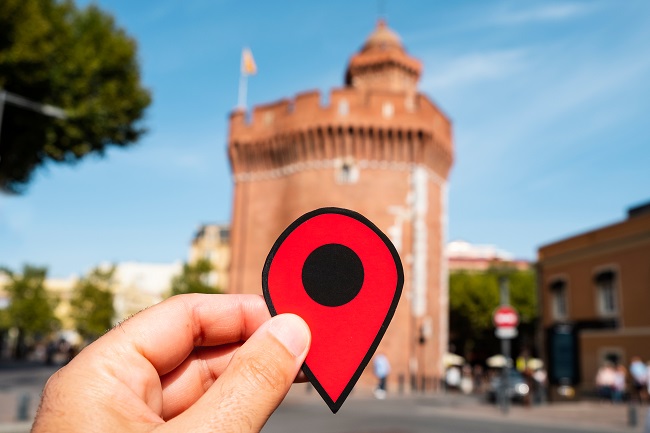
Don’t hesitate to use a GPS to find your way © nito / shutterstock
Turn the GPS on
Once you’re in the driver’s seat, set up a GPS app on the car screen or on a mounted device to get you to your destination. Make sure it is one you are familiar with and that you like. Apple Maps, Google Maps, Waze etc. – it’s your choice but a clear map with instructions spoken by a voice you easily understand takes much of the confusion out of trying to read street signs. Paris signs have a lovely blue style but are often hard to read and are found in inconsistent places on street corners. GPS saves the drive.
Seatbelts on, earphones out
Also, make sure everyone in the car has on their seat belt and kids are using their child restraint systems. Both systems are mandatory in France. Another law: mobile phones may be used only with hands-free Bluetooth technology. Holding a mobile device while driving Is illegal. Earphones cannot be used for calls.
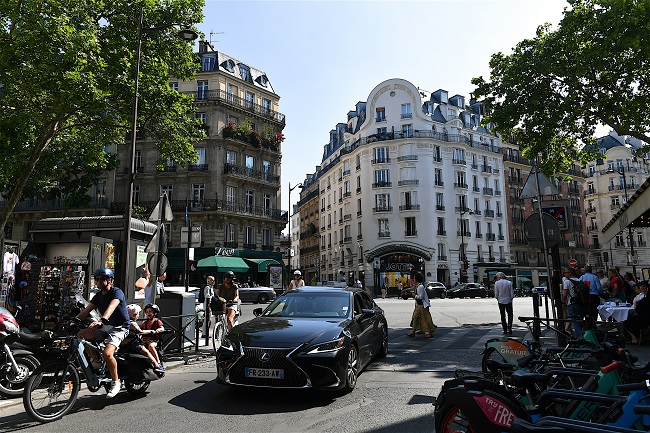
Navigate cyclists, pedestrians, scooters and buses in Paris © Oliverouge 3 / shutterstock
Pedestrians and cyclists also follow the opportunity rule!
Driving in Paris can seem confusing but remember the opportunity rule. The mayor of Paris, Anne Hidalgo, has built bike lanes throughout the city to make it easier and safer for those on two-wheelers or two feet. That has channeled cars, trucks and motorbikes into one or two lanes. This has actually created a lot of the visual confusion as the two-wheelers/walkers don’t always stay in their appropriate lanes and many pedestrians, bicyclists and motorcycles weave their way through traffic finding the smallest of opportunity passages.
In fact, bikes and pedestrians have the right of way where marked. They are supposed to follow the lights and only cross a street on a green but opportunity drives them to cross a road when it works for them. While their actions are not always legal, there are rarely any consequences. That means they will cross on a red light if a car hesitates, if a large group is still crossing or just because they feel they can. Don’t get mad. Just wait for your opportunity to safely cross before you go through an intersection or cross walk and be prepared to stop suddenly for an outlier crossing in front of you.
Watch your speed
Follow the posted speed limits even if the speed seems slow for the traffic flow. The newer speed cameras use smart technology that can not only identify speeding cars but are programmed to identify drivers who are occupied by eating, drinking and using cell phones and earbuds while driving. The rental car company will be sent the ticket which will be passed on to the offending driver.

Exit lanes on the ‘autoroute’ © Martha Sessums
Aim for the autoroutes
Once out of Paris, driving gets less hectic and can be great fun. The roads are smooth and there are rarely potholes or bumps. Drivers have a choice of using local roads for free or paid routes called autoroutes. These are managed by independent companies and all drivers pay a reasonable price for driving on excellently maintained roads. Most roads in France are well maintained but the best – and often the fastest to your destination – are the autoroutes.
To get on an autoroute, take a ticket at the entry gate. Payment is upon exit. (There are some short autoroutes that require payment upon entering, but those are not the main ones.) Look for lanes with credit card outlines or a green arrow to pay via credit card. Lanes with an orange “t” are for paying with Liber-t’s automatic payment method.
Don’t forget to take breaks and fill up the tank!
On long drives, getting gas or taking a driving break is easy. Each rest stop, or les aires, has a unique name. There are two types and their available facilities will be posted several kilometres before the exit. Larger ones have gas stations and a shop for coffee, drinks and snacks. The smaller ones have nice park areas to stretch legs and take a break. All have restrooms.
Buying gas is classic – fill up the car and pay. Most gas stations have payment at the pump but smaller ones require payment inside the gas station first. Know if your car uses gas (essence) or diesel (gasoil). If the car is diesel, make sure the AdBlue tank is full. The car will provide a warning if the tank is low and AdBlue can be bought at any gas station.
Read more: The Rosy Road to Provence: A Wine Tour in the South of France
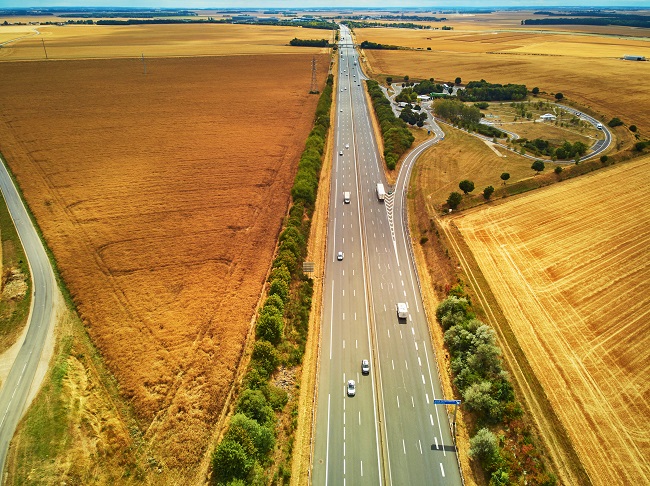
French motorways are very well-kept and provide lovely break areas © Ekaterina Pokrovsky / shutterstock
The unwritten passing rules
Drive in the right lane unless passing. Slower drivers must yield to cars going faster even if they are traveling at an illegal speed. Just move to the right and let the car pass. You can return to the left lane if you’re moving faster than traffic on the right, but be prepared to move back and forth based on each driver’s speeds. Driving in France is not a contest.
Trucks are required to stay in the right lane but passing slower trucks is allowed. Be watchful and give a passing truck the right of way. The truck will pull back to the right once the slower truck is passed.
Relax and enjoy the open roads
Traffic flows can be smooth but les bouchons or traffic jams are universal. Drivers will experience them often coming into a big city, especially Paris, or if there is an accident or road work. Just be patient. All drivers are frustrated with les bouchons, but every driver gets through them. Relax. Enjoy the scenery.
One new addition to some of the autoroutes are the animal crossing bridges. These allow all wild animals such as deer, rabbits and wolves to cross the highways that cut through their territory. Many animals have been killed on the autoroutes and hitting an animal often damages the car. The bridges can be identified by their wooden sides.
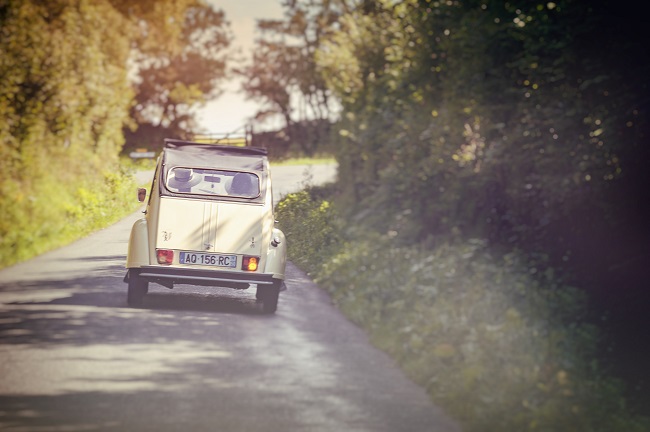
Don’t forget to enjoy yourself! © Massimo Santi / shutterstock
A driving adventure in France can add to any traveller’s experience. Don’t be afraid of driving in Paris. Just take it easy and remember to smartly choose your opportunity in tight traffic situations. Once on les autoroutes, the beauty of the French countryside is inspiring. You’ll be hooked and want to always drive in France.
Read more: Top Places on the Provence Wine Route
Lead photo credit : Driving in France can be a real pleasure, particularly with such a view! © Leonid Andronov / shutterstock
Share to: Facebook Twitter LinkedIn Email
More in driving in France, driving rules, French road trips, Paris, roadtrip, travel tips
Leave a reply
Your email address will not be published. Required fields are marked *

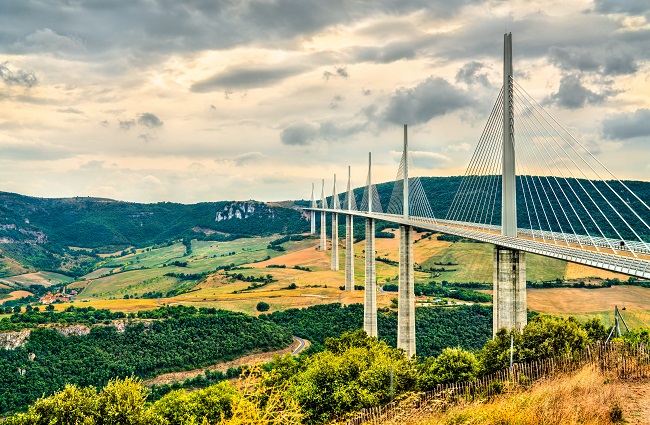

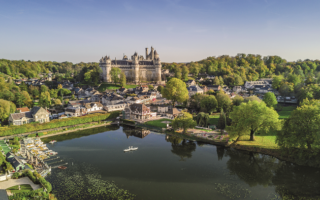


REPLY